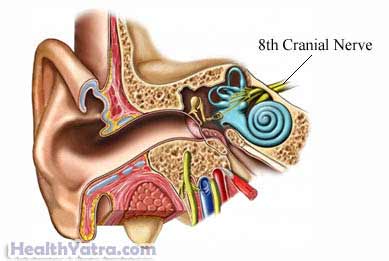Definition
Deafness means a lack or loss of the sense of hearing, which may be partial or complete. Partial loss of hearing is often called hearing loss rather than deafness. Deafness can occur in one or both ears.
There are three primary types of hearing loss:
- Conductive—hearing loss caused by the inability of the sound to reach the inner ear. This can result from outer or middle ear problems, such as ear infection, excess wax, or swelling. This type of hearing loss is most likely to respond to medical or surgical treatment.
- Sensorineural—hearing loss caused by disorders of the inner ear or auditory nerve. This type of loss is usually permanent. It can be caused by heredity or congenital problems, excess noise, old age, medications, infections, andmeningitis, or from tumors compressing the nerve of hearing such as an acoustic neuroma.
- Mixed—hearing losses that are a combination of both conductive and sensorineural loss.

Causes
The conditions that can cause or be associated with hearing loss include the following:
- Ear infections
- Middle ear fluid
- Earwax
- Hole in the ear drum
- Trauma may cause rupture of the tympanic membrane and disruption of the middle ear ossicles, or concussion of the inner ear
- Nose or throat problems, such as:
- Nasal allergies
- Sinus problems
- Blockage of the tubes leading from the ears to the throat
- Hereditary factors
- Birth defects
- Trauma, injury, or fracture
- Noise
- Ear disorders, such as:
- Otosclerosis
- Meniere’s disease
- Infections, such as:
- Viral infections
- Mumps
- Bacterial infections, such as:
- Syphilis
- Meningitis
- Otitis media
- Tumors involving the:
- Ear
- Brain
- Neurological disorders, such as:
- Multiple sclerosis
- Stroke
- Hypothyroidism—underactive thyroid
- Ototoxic drugs that damage the ear, such as:
- Aspirin—usually reverses when aspirin is stopped
- Quinine—usually reverses when quinine is stopped
- Certain antibiotics—usually is not reversible when stopped
Risk Factors
Deafness may occur at any age. Risk factors that increase your chances of deafness include:
- Premature birth
- Increased age
- Taking ototoxic medications
- Exposure to loud noise on the job, such as:
- Loud industrial noise
- Use of heavy equipment
- Being a musician
- Exposure to recreational loud noise, such as:
- Guns used during target practice
- Loud music
- Family history of deafness
Symptoms
Hearing loss usually comes on gradually, but may come on suddenly. Symptoms may include:
- Difficulty hearing
- Ringing in the ears, also called tinnitus
- Dizziness
- Ear pain in case of an infection
- Feeling of ear fullness, such as that caused by earwax or fluid
Symptoms of deafness in infants may be noted at these stages:
- 1 to 4 months: lack of response to sounds or voices
- 4 to 8 months:
- Disinterest in musical toys
- Lack of verbalization, such as babbling, cooing, making sounds
- 8 to 12 months: lack of recognition of child’s own name
- 12 to 16 months: lack of speech
All children, including newborns, should be screened for hearing loss.
Diagnosis
Your doctor will ask about your symptoms and medical history. A physical exam will be done. As part of the diagnosis, your doctor may try to determine the following:
- Location of the problem
- Degree of loss
- Cause—not always possible to identify the exact cause of hearing loss; this information can help guide treatment
Depending on the type of hearing loss you have, the doctor may order tests to confirm your diagnosis. Tests may include:
- You may have the structures inside your ears examined. This can be done with otoscopy.
- You may have the fluid in your ear measured. This can be done with tympanometry.
- You may have your brain’s electrical response tested. This can be done with a brainstem auditory evoked response test.
- You may have tests to determine your hearing loss. These may include:
- Bone vibrator—also called a tuning fork test
- Audiogram—also called a hearing test
- You may have images taken of your head. This can be done with:
- CT scan
- MRI scan
Treatment
Treatment for deafness depends on the type of hearing loss. Options may include:
- Medical treatment, such as removal of earwax or use of antibiotics to treat an ear infection
- In selected cases of sudden hearing loss, medical treatment with steroids may be effective.
- Hearing aids to help amplify sounds
- Surgery, such as:
- Stapedectomy—for treatment of otosclerosis
- Tympanoplasty —for a perforated eardrum
- Tympanoplasty tubes—for persistent middle ear infections or fluid
- Cochlear implant —a surgically implanted electronic device that helps provide sound to a person with severe sensorineural hearing loss. Although the devices do not completely restore hearing, improvements in implant technology continue to be made.
Prevention
To help prevent deafness, avoid loud noise. In cases when loud noise cannot be avoided, you can reduce exposure to loud noises by wearing earplugs, earmuffs, or ear protectors. Also, taking steps to reduce injuries or disease may prevent certain types of deafness.
There is currently no effective way to prevent congenital or genetic deafness. Hearing screening for newborns can help ensure that hearing loss in young babies is detected and treated at the earliest possible stage.
Keywords :
Deafness Definition, Deafness Causes, Deafness Symptoms, Deafness Complications, Deafness Surgery Cost in India, Deafness Treatment Hospital in India, Deafness Treatment in India, Deafness Doctors in India, Deafness Meaning in Hindi, Deafness Meaning in Bengali, Deafness Meaning in Arabic, Deafness Treatment cost in 2024, deaf population in india 2024, causes of deafness, prevalence of hearing loss in india, deafness in india, india deaf population, national programme for prevention and control of deafness slideshare, incidence and prevalence of hearing loss in india, national association of the deaf india,
